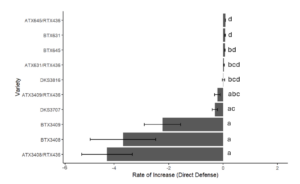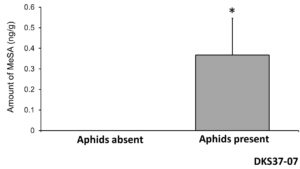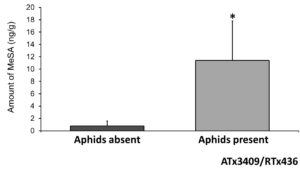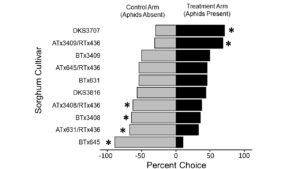Progress report for GS23-280
Project Information
Resistant sorghum varieties and resident natural enemies play a crucial role in suppressing the sorghum aphid (Melanaphis sorghi) and enhancing profitability and sustainability of sorghum growing operations. This economically relevant pest has invaded over 90% of sorghum-growing states and caused millions of dollars of damage. To continue to develop and deploy resistant varieties, it is critical to understand which resistance traits can effectively control pests. Plant volatiles, or chemical compounds that assist natural enemies in locating their prey, are plant traits that have yet to be incorporated into resistant varieties. Our previous work has identified one variety that both decreases aphid reproduction (antibiosis) and produces plant volatiles to attract natural enemies. Our preliminary field experiments have shown that this dually resistant variety not only maintains lower aphid abundances, but also attracts significantly more natural enemies compared to varieties without this trait. The main objectives of the project are: 1) screen a broad range of sorghum varieties for both antibiotic and volatile traits and 2) assess if varieties with enhanced resistance will also have enhanced yield and suppress aphids across multiple growing regions. We will test both experimental and commercially available hybrids. This will allow us to identify genetic sources of different resistance traits for future crop breeding and inform growers on which varieties best suppress pests for their growing region. Using dually resistant varieties will allow growers to control aphids using both host plant resistance and biological control, thereby decreasing the need for insecticide applications, increasing yield, and increasing profitability.
Objective 1: Screen 10 varieties of sorghum for antibiotic and volatile resistance traits. We predict that sorghum varieties will vastly differ in their propensity to decrease aphid population growth and attract natural enemies.
Objective 2: Measure the effectiveness of 5 dually resistant sorghum varieties at suppressing aphids and producing high yields in several growing regions of Texas. We predict that varieties with both antibiotic and volatile traits will better protect sorghum from sorghum aphid than varieties with only antibiotic traits. Dually resistant varieties will keep aphid populations from growing and kill remaining aphids via attraction of natural enemies such as insect parasitoids and predators. In addition, we predict that dually resistant varieties will protect sorghum in different growing regions, making it effective for a broad range of growers. We also predict that dually resistant varieties will have enhanced yield, owing to their genetic background and enhanced resistance to aphid damage.
Cooperators
- (Researcher)
Research
Objective 1:
Ten varieties will be screened for antibiotic and volatile traits (see Table 1). Five experimental and five commercial varieties were selected based on known resistance/susceptibility to the aphid, pedigree, and agronomic qualities.
Plants will be reared in the laboratory to maintain sorghum aphid colonies for laboratory and field experiments and to complete volatile and antibiosis assays. One seed will be planted per pot in growing medium and will be grown in a greenhouse at 28-32 ℃ with supplemental light and maintained in insect-proof tents. Sorghum aphid colonies will be established with aphids collected from sorghum in College Station, Texas in June of 2020. Colonies will be maintained on susceptible sorghum plants in a growth chamber at 30℃, 40% RH, and 12:12 light:dark cycle. Aphids from laboratory colonies will be used to infest plants in volatile assays, antibiosis assays, and the field experiment.
We will use previously established methods to collect volatiles from infested sorghum plants to identify and quantify volatile compounds produced by different sorghum varieties. Ten sorghum varieties will be grown in the fashion as described above. The sorghum plants will either be inoculated with 50 aphids 48 h prior to volatile collection or remain aphid-free. There will be at least 10 replicates of each treatment per variety. Collections will be performed in walk-in growth rooms. Volatiles from leaves of individual plants will be collected in heat-resistant oven bags. Air will be filtered and pumped into the oven bags while a vacuum pump will pull air out of the oven bags at the same time. Volatiles will be pulled into a volatile filter trap. Volatiles will be eluted from the volatile filter traps. These volatiles will be quantified using a gas chromatograph and mass spectrometer using established techniques. To identify volatile compounds, we will compare mass spectra and retention times with published libraries of volatile data. We will use ANOVAs to compare amounts of individual volatile compounds among varieties.
To determine if sorghum varieties affect aphid reproduction via antibiotic traits, we will measure aphid population growth rate on sorghum plants. Plants will be grown as described above and infested with 50 aphids 48 h prior to the start of the experiment. There will be at least 10 replicates per variety. Aphid numbers on each plant will be counted each day for seven days total. Population growth rate will be calculated, and ANOVAs will be used to compare the strength of antibiosis among varieties.
Objective 2:
From our volatile and antibiosis assays, we will select a subset of five varieties that will vary in resistance traits. We expect to have some varieties with both antibiotic and volatile traits, some varieties with only antibiotic traits, and some varieties that are susceptible to sorghum aphid. Our preliminary screening of a few varieties has shown that all these combinations exist among the varieties tested. Varieties will be planted at experimental farms belonging to Texas A&M in the following locations: College Station, Amarillo, and Corpus Christi. These locations are in the panhandle and central plains, where most of the sorghum production occurs in Texas. Plots will be eight rows wide and ~12 m (40 ft) long and will be arranged in a randomized complete block design. Plots will be treated with an herbicide to reduce weed growth, but no insecticides will be applied to the field. Sorghum will be watered monthly through flood irrigation.
At boot stage, 20 plants in the center of the plots will be artificially infested with 50 sorghum aphid per leaf using leaf clippings from laboratory colonies. Plants will be re-infested as needed to ensure that all plants have approximately the same aphid densities. Yield will be measured for all varieties both years. Each variety will be replicated four times (n=20 total plots per site).
To determine the effect of sorghum variety on sorghum aphid suppression and natural enemy attraction, we will count sorghum aphids, parasitoid mummies, parasitoid adults, and predators on two leaves of the plants within the plots (one upper and one lower leaf). Measurements will be taken once a week from boot stage until plant maturity. Parasitoid mummies will be brought back to the laboratory to confirm identification. All natural enemies will be identified to the species level. Aphid densities above 50 will be approximated by counting in increments of 50, as aphid population growth can quickly grow to large sizes such that actual counts are not possible.
To estimate how much the attracted resident natural enemies contribute to aphid suppression, we will use exclusion cages. Within the experimental plots, another twelve plants at the boot stage will randomly be selected, with six plants being assigned to each treatment. The two treatments will be: 1) caged plants and 2) uncaged plants. Caged plants will exclude natural enemies, which will help us estimate how much antibiotic traits alone contribute to sorghum aphid suppression. Conversely, natural enemies will be able to access sorghum aphid on uncaged plants. The frame of cages (1 sq. m wide and 1 sq. m tall) will be constructed from PVC and a fine mesh sleeve will be placed over the PVC frame to exclude all natural enemies. Once plants reach the boot stage, we will infest each leaf with 40 sorghum aphids and all sorghum aphids will be sourced from the laboratory colony. Cages will then be placed over the assigned plants and after a one-week period, cages will be removed, and sorghum aphid densities will be counted. Estimates of sorghum aphid densities at the end of the experiment will be used to calculate percent suppression attributable to natural enemies.
For the field experiment, mixed model ANOVAs will determine whether changes in sorghum aphid density, natural enemy density, and days below the action threshold (50 aphids/leaf) are because of plant resistance traits. For the field cage study, we will use ANOVAs to compare sorghum aphid densities among varieties. We will also compare our results across sites to determine if varieties performed similarly.
Results for Objective 1
For objective 1, our goal was to screen ten sorghum cultivars for variation in two types of resistance: 1) antibiosis and 2) volatile emissions and subsequent attraction of beneficial insects.
To assess antibiosis, we measured reproductive capacity (i.e., rate of increase of aphid populations) of the sorghum aphid on these cultivars. In total, we screened eight experimental sorghum lines from the Texas A&M AgriLife Research Sorghum Improvement Program and two commercial hybrids (Bayer). Since the exact chemical compounds and structural traits underlying antibiosis against sorghum aphids are less understood (Puri et al. 2023, Kiani and Szczepaniec 2018), it is common practice to instead measure pest performance on these cultivars. We found great variation in antibiosis amongst sorghum cultivars (Kruskal-Wallis χ2=67.71, p<0.0001) (Fig. 1). Out of the ten cultivars, half had negative values for rate of increase, meaning that aphid populations decreased on these cultivars. ATx3408/RTx436, BTx3408, and BTx3409 exhibited the strongest antibiotic defenses, whereas DKS3707 and ATx3409/RTx436 showed intermediate levels. The remaining five cultivars (ATx631/RTx436, BTx645, DKS3816, ATx645/RTx436, and BTx631) had similar positive values of rate of increase, meaning aphid populations grew on these cultivars.

To assess volatile emissions, we assigned sorghum seedlings to two treatments: 1) infestation with 100 aphids and 2) no aphids added. Plants were placed in individual heat-resistant oven bags with filters attached, such that air could be pumped into and out of the bags for volatile collection over an 8 hour period. Then, using a GC-MS, we identified and quantified volatile compounds.
The total amounts of volatiles induced by aphids did not differ among cultivars (Fig. 2), but there was considerable variation in the blends of volatiles emitted by these plants.

Using random forest analyses (a machine learning technique), we found some interesting patterns in volatile emissions amongst the cultivars. Namely, two cultivars (ATx3409/RTx436 and DKS3707) had increased emissions of methyl salicylate (MeSA) after aphid feeding (Figs. 3 and 4). MeSA is produced by a variety of crop plants and has been shown to be highly attractive to many different beneficial insects in the laboratory and field (De Boer and Dicke 2004, Rodriguez-Saona 2011).


Then, to test how attractive the volatile blends were to beneficial insects, we used olfactometer choice tests. Briefly: Sorghum seedlings were assigned to be infested with aphids or un-infested. These two plants of the same cultivar were then placed into the olfactometer jars, where airflow moved odors into the base of the y-tube. At the base of a y-tube, we placed an individual female parasitoid (Aphelinus nigritus). Parasitoids were inside of the tube for 5 minutes and allowed to make a choice between the right or left arm of the tube, toward their preferred odor.
Parasitoids significantly preferred aphid-induced DKS3707 and ATx3409/RTx436 (Fig. 5). However, parasitoids showed no preference toward aphid-infested and un-infested BTx3409, BTx631, and DKS3816 plants. Moreover, parasitoids were seemingly repelled by aphid-induced volatiles from ATx3408/RTx436, BTx3408, ATx631/RTx436, and BTx645 plants.

Discussion for Objective 1
An exciting outcome from these results is that two cultivars, ATx3409/RTx436 and DKS3707, exhibit both antibiosis and volatile-mediated attraction of a beneficial insect. These cultivars are candidates for future crop breeding efforts, as we can combine direct resistance traits and traits that can enhance biological control of pests. Further field testing (i.e., Objective 2) is necessary to ensure that these sorghum cultivars can enhance both beneficial insect attraction and pest suppression. Other field studies have shown promising results - for example, a cabbage cultivar emitting higher amounts of MeSA attracted more parasitoids and had higher parasitism of caterpillars (Poelman et al. 2009). In the case of these two cultivars, we hypothesize that MeSA is the volatile that is driving attraction of parasitoids, but we will need to conduct more olfactometer assays to directly test this.
Another important finding from this study has been that total volatile emissions were not predictive of beneficial insect attraction, and that differences in volatile blends may be a more accurate measure. Other studies have found similar patterns (Degen et al. 2012, Lou et al. 2006). For example, Cotesia parasitoids could distinguish between two maize cultivars making similar amounts of total volatiles, suggesting that individual volatiles are important for locating prey (Hoballah et al. 2002).
Finally, it should be noted that some cultivars appeared to repel parasitoids, as they preferred un-infested over aphid-infested plants. In the present study, it was difficult to determine which volatiles may lead to this response. Other studies have also found that crop cultivars can repel beneficial insects: for example, Kappers et al. (2011) found that cucumber varieties emitting certain volatiles were unattractive to predatory spider mites. Field tests, like in our second objective, may clarify whether these plants can actually repel beneficial insects.
Educational & Outreach Activities
Participation Summary:
One presentation at the Entomological Society of America Joint North Central and Southwestern Branch meeting was given to present Objective 1 of this project.
Project Outcomes
By completing Objective 1, we have successfully identified sorghum cultivars that not only directly affect aphid reproduction, but also attract a major beneficial insect. These cultivars may be used for future crop breeding and improvement efforts. Additionally, the assays and screens to find antibiosis/antixenosis traits don't identify the physical structures or chemicals that confer resistance. With our volatile data, we have found the actual chemicals that mediate attraction of beneficial insects, which may further assist crop breeders in identifying genes and biochemical pathways that play a role in this type of resistance.
Sorghum aphid management heavily relies on insecticidal applications, which can potentially lead to insecticide resistance in aphid populations. Additionally, one of the insecticides used requires yearly Section 18 exemptions, due to its harmful effects on pollinators (EPA 2016). Current resistant cultivars are also only partially resistant to the aphid. Our work identifies new resistance traits that can enhance pest suppression, thereby improving the sustainability of sorghum aphid management. Our second objective aims to test whether these cultivars we have identified are better protected against aphid infestations and have improved yield.
This project has allowed myself and Dr. Helms the opportunity to work with a sorghum breeder (Dr. William Rooney) to better understand what traits are screened for to provide growers with resistant sorghum cultivars. We have learned that crop breeders generally focus on a narrow set of resistance traits, including antibiosis, antixenosis (non-prefrence), and tolerance. However, our work has found that these categories do not include all potential resistance traits and ones that can enhance biological control (like volatiles) are not considered. In this work, we have realized that there are still considerable knowledge gaps in implementing crop resistance into pest management. The sustainability of pest management may be extended and improved by incorporating many kinds of resistance traits into crop varieties that not only directly affect pest reproduction and physiology, but also attract beneficial insects within the agroecosystem.